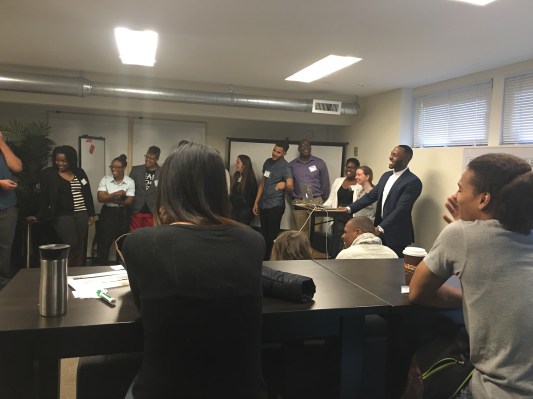Where are all the people of color in engineering roles at tech companies? Berkeley, Calif.-based coding bootcamp Telegraph Academy, which plans to relocate to Oakland in the next few months, wants to make it so that the tech industry has no excuse not to hire black and latino/a people for technical roles.
“First and foremost we wanted to be in a city that was racially diverse and had strong communities of color who would be excited about this,” Telegraph Academy Founder Albrey Brown told TechCrunch. “The origin of our name comes from finding out that Oakland, California is one of the most racially diverse cities in America and that the oldest street in Oakland is Telegraph Ave. Secondly, we did a lot of research and found that there was nobody in the market with our offering, a professional Software Engineering career in as little as three months. Being able to build a bridge to the Valley in such a unique place is a huge opportunity for us.”
Telegraph Academy’s coding bootcamp is part of the prestigious Hack Reactor network, which has a 99% hiring rate and partnerships with over 30 tech companies. Telegraph Academy started after Brown went through Hack Reactor in June 2014, and ultimately felt that the program could be beneficial to people of color in the San Francisco Bay Area, but with an added emphasis on what it’s like as a person of color trying to become a better engineer.
“When coming to the idea of offering a bootcamp experience to people of color, I wanted to start at a baseline of excellence,” Brown said. “That’s what I wanted to offer first and foremost. We also wanted to build off of it by having some flavor of our own, like leadership and brand building geared toward people of color.”
I visited Telegraph Academy at its headquarters in Berkeley on day one of its second bootcamp. The day kicked off with a welcome lecture by Brown, in which he gave the 11 students an honest, no-bullshit idea of what to expect in the next three months.
“If you can think about the most difficult thing you’ve done, multiply it by 1,000, and you’re probably not even close,” Brown told the students on day one. He later said, “Our job is to make you as uncomfortable as possible all of the time and push you towards mastering something — a concept that you’ve never even thought about it — and enjoy that process of feeling uncomfortable.”
Through Telegraph Academy, students get access to equipment, space to hack for 12 hours a day, every week day, lectures, facilitated collaboration, job search support, solution walkthroughs and more. In the first week (last week), there were be 28 lectures.
“It’s going to be a shit show in the best way possible,” Brown told the students.
Next up was a session on recursion. Although I knew absolutely nothing about recursion — yet alone had ever heard the word before that day — I decided I was officially in over my head once the instructor started talking about stringifiable objects and JSON.
[gallery ids="1267963,1267966,1267968"]
Telegraph Academy’s first cohort started in June 2015. Since then, Brown has realized that there’s been “a bit of a culture shock” for Telegraph Academy graduates because the tech industry isn’t predominantly black and latino, Brown told me.
That’s why Telegraph Academy has started offering a leadership development seminar, where students participate in two-hour, weekly workshops around owning their differences in the workplace and work on “breaking down the racism and subtle microaggressions,” Brown said. “We want to make them well-equipped to handle microaggressions and break them down into constructive criticism.” The leadership development seminar, called Transformational Leadership, is optional but highly encouraged for each student going through Telegraph Academy. Through the coding bootcamp and leadership development seminar, Telegraph Academy’s goal is to prepare its students to work at tech companies like Microsoft, Intuit, Slack, SolarCity, Facebook, Google, LinkedIn and others.
Unfortunately, a lot of those offices are not only based in cities with a lot of white people, IBTimes reported earlier this month, but the companies also employ a lot of white people. Just look at some of the recent diversity reports from Dropbox, Apple and Google. Although Uber’s imminent move into Oakland — a city that is 34.5% white, 28% black and 25.4% hispanic, according to 2014 census data — has sparked some controversy, Uber says it’s committed to being a good neighbor, achieving equity, fighting displacement and supporting the local economy. Uber has been on a “listening tour” in Oakland, meeting with local organizations to see how the Unicorn can be a true partner when it lands in Oakland. Uber Global Diversity and Inclusion Lead Damien Hooper-Campbell has personally met with Telegraph Academy, and has given them an overview of Uber’s goals and strategies around diversity, inclusion and community engagement.
“We’re really excited about his ideas and to see Uber taking the initiative in improving diversity in tech,” Brown said. “There’s a clear synergy with what we’re doing to broaden opportunity for people of color.”
Ultimately, Silicon Valley should not be limited to just San Francisco and the Peninsula, Brown said. There’s Silicon Beach in the Los Angeles area, Silicon Desert in Phoenix and other innovation ecosystems in other cities throughout the country, and even the world.
“Tech is spreading, and the bootcamp model makes sure as many people as possible have access to the education to get them into it,” Brown said. “If not, we’re putting our city economies at risk.”
